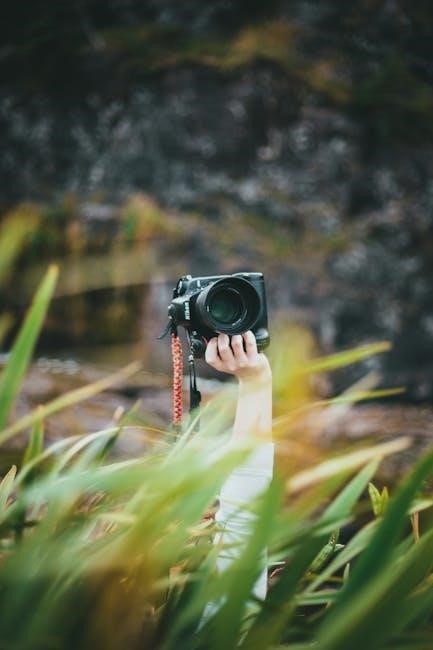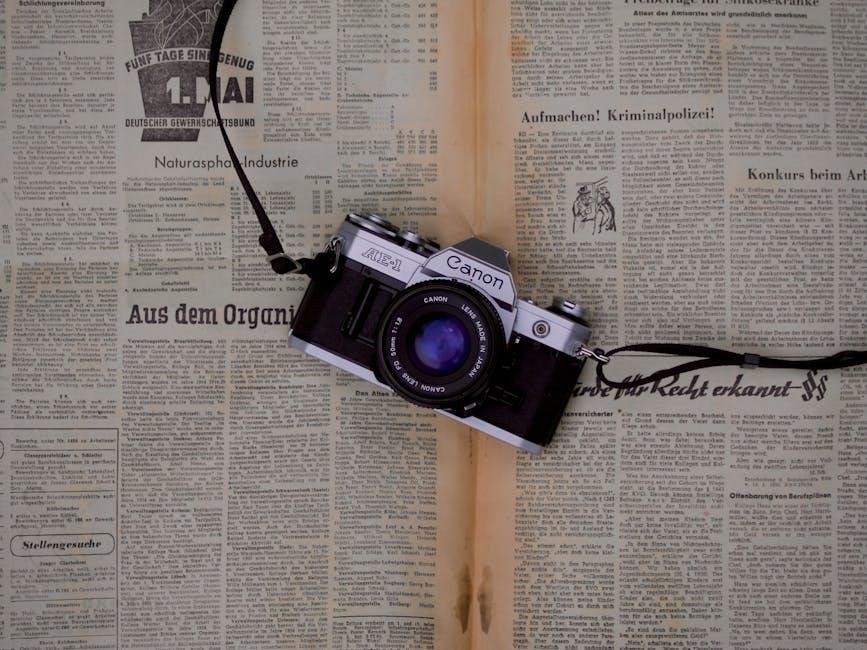
canon ae 1 camera manual
Welcome to the Canon AE-1 Camera Manual! This guide provides essential information to help you master the iconic Canon AE-1, a landmark in photography history.
Discover its features, operation, and maintenance to unlock its full potential for capturing stunning images with ease and precision.
Welcome to the Canon AE-1 Camera Manual
Welcome to the Canon AE-1 Camera Manual! Congratulations on acquiring this iconic camera, a landmark in photography history. This manual is designed to guide you through the features, operation, and maintenance of your Canon AE-1, helping you unlock its full potential. Whether you’re a seasoned photographer or just starting out, this manual will provide the essential information you need to master your camera. With detailed instructions on loading film, setting exposure modes, and troubleshooting, you’ll be equipped to capture stunning images with ease and precision. Let’s dive in and explore everything your Canon AE-1 has to offer!

About the Canon AE-1 Camera
The Canon AE-1 is a legendary 35mm film SLR camera introduced in 1976, renowned for its durability and intuitive design. It was designed to be user-friendly, catering to both professionals and hobbyists. The AE-1 features a built-in light meter, supporting three exposure modes: Program AE, Shutter-Speed Priority AE, and Manual Override. Compatible with Canon FD-mount lenses, it became a favorite for its versatility and reliability. Its impact on photography history is undeniable, making it a sought-after collectible today. This camera embodies a perfect blend of innovation and simplicity, ensuring its place in the hearts of photographers worldwide.
Camera Features and Specifications
The Canon AE-1 is a 35mm film SLR camera featuring a built-in light meter, FD lens compatibility, and three exposure modes: Program AE, Shutter-Speed Priority AE, and Manual Override.
Key Features of the Canon AE-1
The Canon AE-1 boasts a built-in light meter, enabling precise exposure control. It supports FD lenses, offering versatility for photographers. The camera features three exposure modes: Program AE for automatic settings, Shutter-Speed Priority AE for manual control over shutter speed, and Manual Override for complete user control. Its durable design ensures longevity, while the intuitive controls make it user-friendly. The AE-1 is also compatible with various accessories, enhancing its functionality. These features make it a versatile tool for both amateur and professional photographers, ensuring exceptional image quality and creative flexibility. Its legendary status is well-deserved among photography enthusiasts worldwide.
Technical Specifications
The Canon AE-1 operates with a 35mm film format, supporting ISO ranges from 12 to 4000. It features a horizontally traveling focal-plane shutter with speeds from 2 seconds to 1/1000th of a second, plus Bulb mode. The built-in TTL metering system ensures accurate exposures, while the camera’s sync speed is 1/60th of a second for flash photography. The AE-1 is compatible with FD-mount lenses, offering a wide range of optical options. Its dimensions are 148 x 90 x 47.5mm, weighing approximately 590 grams without the lens. These specifications make it a reliable and adaptable choice for photographers seeking precision and durability.

Understanding the Camera Controls
The Canon AE-1 features intuitive controls, including the film advance lever, shutter speed dial, aperture ring, and mode selector. These controls enable precise adjustments for optimal shooting.
External Controls and Their Functions
The Canon AE-1’s external controls are designed for easy operation. The film advance lever advances the film and cocks the shutter. The shutter speed dial allows selection of speeds from 1/1000 to B. The aperture ring on the lens controls the f-stop. The mode selector switches between Program AE, Shutter-Speed Priority AE, and Manual modes. The exposure compensation dial adjusts exposure by ±2 stops. The ASA/ISO selector sets the film speed. These controls provide intuitive access to camera functions, ensuring quick and precise adjustments for various shooting scenarios.
Operating Modes: Program AE, Shutter-Speed Priority AE, and Manual Override
The Canon AE-1 offers three versatile operating modes. Program AE mode automatically sets both aperture and shutter speed for effortless photography. Shutter-Speed Priority AE allows you to set the shutter speed, while the camera adjusts the aperture. Manual Override provides full control over both aperture and shutter speed for precise adjustments. These modes cater to both beginners and advanced photographers, ensuring flexibility in various lighting conditions. Use the mode selector to switch between options, enabling you to capture images with ease and creativity, whether you prefer automation or manual control.

Loading Film and Initial Setup
Loading film into the Canon AE-1 is straightforward. Set the film speed by pushing the film advance lever to its stand-off position, ensuring proper camera function.
How to Load Film into the Canon AE-1
Open the camera back by sliding the release latch. Insert the film cartridge, ensuring it aligns with the spool. Pull the film leader to the take-up spool. Advance the lever to secure the film. Close the back and set the film counter. This process ensures proper loading for optimal performance.

Setting the Film Speed
To set the film speed on your Canon AE-1, locate the ASA/ISO dial on the top of the camera. Align the dial with the film’s speed rating, such as ASA 100 or 400. Rotate the dial until the desired speed clicks into place. Ensure the film advance lever is in its stand-off position before setting the speed. This step is crucial for accurate exposure settings. Refer to your film cartridge for the correct ASA/ISO value. Properly setting the film speed ensures optimal exposure and image quality. Always double-check the setting before shooting to avoid under or overexposure issues.
Exposure Modes and Shooting
The Canon AE-1 offers Program AE, Shutter-Speed Priority AE, and Manual Override modes, providing flexibility for automatic and manual control in various shooting conditions.
Using Program AE Mode
In Program AE mode, the Canon AE-1 automatically sets both aperture and shutter speed for optimal exposure. This mode is ideal for beginners or quick shooting situations.
To use Program AE, set the mode dial to “PROGRAM” and adjust the film speed. The camera will adjust settings based on the built-in light meter for precise results.
This mode simplifies photography, allowing you to focus on composition and subject matter while the camera handles exposure calculations, ensuring sharp and well-exposed images every time.

Shutter-Speed Priority AE and Manual Override
In Shutter-Speed Priority AE mode, you set the desired shutter speed, and the camera automatically adjusts the aperture for optimal exposure. This mode is ideal for controlling motion blur or freezing fast-moving subjects.
Manual Override allows full control over both aperture and shutter speed, enabling precise adjustments for creative effects. Use the light meter in the viewfinder to ensure accurate exposures, making it perfect for experienced photographers seeking customization and control over their shots.

Troubleshooting and Maintenance
Address common issues like inaccurate metering or shutter malfunctions. Regularly clean the lens and viewfinder to ensure optimal performance.
Replace batteries periodically and store the camera in a dry, cool environment to maintain longevity and functionality.
Common Issues and Solutions
Common issues with the Canon AE-1 include improper film loading and battery compartment latch problems. For film loading, ensure the film is securely attached to the spool and advance properly. Battery issues can be resolved by cleaning the contacts or replacing them. Shutter malfunctions may require professional servicing. Regular maintenance, such as cleaning the lens and viewfinder, prevents operational hiccups. If the metering is inaccurate, check the battery power and ensure the lens is clean. These simple solutions can restore your camera to optimal functionality, ensuring great photography experiences.
Maintenance Tips for Longevity
Regular maintenance ensures the Canon AE-1 performs optimally for years. Clean the lens and viewfinder with a soft cloth to prevent dust buildup. Store the camera in a dry place to avoid moisture damage. Use silica gel packets to maintain humidity control. Check and replace the light seals periodically to prevent light leaks. Avoid exposing the camera to extreme temperatures. Use a blower to remove dust from the mirror and shutter mechanism. For deep cleaning, consult a professional. Proper care extends the lifespan of your Canon AE-1, ensuring it remains a reliable tool for capturing timeless moments.